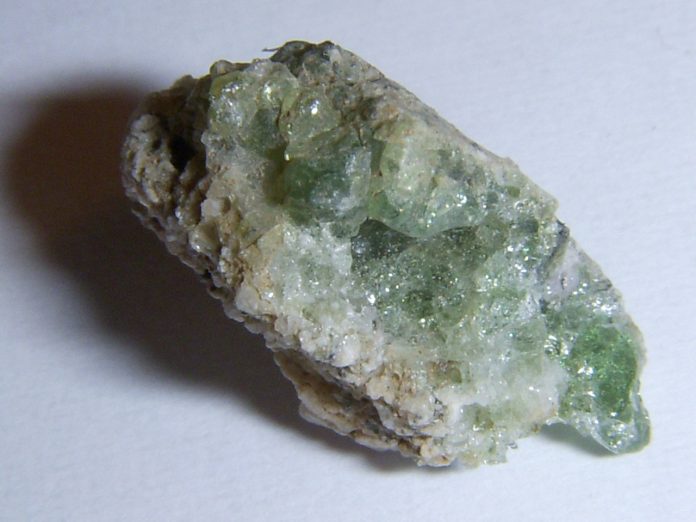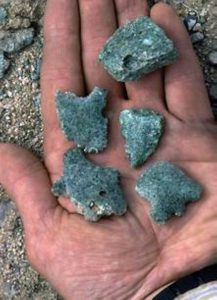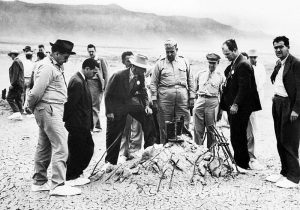
Fission and Fusion
Trinitite was created at 5:29 a.m. on July 16, 1945, when a plutonium-implosion fission device was detonated at Trinity Site in the New Mexico desert north of Alamogordo—an event unforgettably portrayed in the Oppenheimer movie. With a TNT-equivalent energy yield of 125 kilotons, the blast’s 3000°F temperatures completely vaporized the 100-foot-tall, steel detonation tower. Two months later, Time magazine described Trinity Site’s ground zero as a shallow, 2,400-foot-wide blast crater that appeared as “a lake of green jade.” The abundant, jade-like material that imparted a greenish color to the crater floor was initially named everything from “atomsite” and “a-bombite” to “Alamogordo glass,” but the name that stuck was “trinitite.”
People were either intrigued or repulsed by all that trinitite represented: top-secret military weaponry, mind-boggling physics, cataclysmic detonations, the dawn of the nuclear age, and the devasting atomic bombing of two Japanese cities.”
Scientists first assumed that trinitite was created when the heat of detonation fused the desert sand. But according to current theory, the greenish glass formed when sand was drawn up into the atomic fireball where it fused before falling in small, molten blobs to solidify on the desert floor.
Trinitite Specimens

Wikimedia Commons
Classified as a man-made glass of indefinite composition and amorphous structure, trinitite consists mainly of quartz with lesser amounts of feldspar, hornblende and pyroxene minerals—the same basic composition as the original sand.
Trinitite specimens vary widely in shape and texture. The most common are flat pieces about one-quarter-inch thick; these are rough on the bottom which contacted the desert floor and smooth on the top where solidification occured in air. Trinitite has a vesicular structure with roughly one-fifth of its mass consisting of “bubbles” of varying sizes. Pea-sized trinitite “pearls” formed when spherules of molten material solidified before falling to the ground.
Most trinitite is a pale, dull brownish-green. Rare black specimens contain iron from the vaporized steel tower; even rarer red colors are caused by copper from vaporized communication wires and cables.
The “Atomic Gemstone”
Within months after the July 16th detonation, trinitite became a popular, yet controversial, collectible. People were either intrigued or repulsed by all that trinitite represented: top-secret military weaponry, mind-boggling physics, cataclysmic detonations, the dawn of the nuclear age and the devasting atomic bombing of two Japanese cities.
Those who were intrigued could purchase trinitite at rock shops, jewelry stores, gas stations, restaurants and roadside stands throughout New Mexico. Lapidaries fashioned trinitite into cabochons for earrings, pins, brooches and pendants, often marketing their creations as “Trinitite—the Atomic Gemstone.” Also popular were rough specimens of trinitite wrapped in silver wire.
Trinitite received national attention in 1948 when top New York jewelry designer Marc Koven combined trinitite with palladium in a well-publicized, atom-shaped hair ornament for Hollywood actress Merle Oberon.
Trinitite was—and still is—mildly radioactive. While normal handling is not a problem, prolonged, direct skin contact, occurring with earrings, did cause several documented cases of radiation burns.
Collecting Trinitite

The supply of trinitite initially seemed limitless. Trinity Site, largely forgotten as nuclear testing shifted to Nevada, remained off-limits to the public. But because of lax security, collectors gathered buckets of trinitite to sell to dealers in Albuquerque and Alamogordo.
Trinitite occurs only in small masses. The largest known specimen measures only six inches and weighs nine ounces. Many fine trinitite collections were built around specimens just an inch or two in size. However, trinitite collecting ended abruptly in 1953 just before Trinity Site’s first public “open house” attracted 650 visitors. Fearing a collecting frenzy, the U.S. Army bulldozed the shallow blast crater to bury the remaining trinitite.”
But trinitite collecting ended abruptly in 1953 just before Trinity Site’s first public “open house” that attracted 650 visitors.
Fearing a collecting frenzy, the U.S. Army bulldozed the shallow blast crater to bury the remaining trinitite.
Trinitite Today
Virtually all trinitite sold today was collected before 1953. Specimens rarely exceed one-half-inch in size and are sold by the gram. Prices begin at about $20 per gram and are considerably higher for larger specimens or those packaged in displays.

However, not all specimens are authentic. Some are mislabeled tektites (sand fused by a meteoric impact); others are nuclear-fused sand collected from atmospheric nuclear test sites in Nevada. And because it is easy to produce mildly radioactive, vesicular, glassy, green silica, trinitite is also faked. Genuine trinitite, however, emits a unique radiation signature that reveals its origin in a plutonium-fission detonation. Most reliable trinitite sources now provide certificates of authenticity with their specimens.
Oppenheimer: The Movie
Trinitite was created at 5:29 a.m. on July 16, 1945, when a plutonium-implosion fission device was detonated at Trinity Site in the New Mexico desert north of Alamogordo—an event unforgettably portrayed in the Oppenheimer movie.
Moviegoers intrigued by Oppenheimer will enjoy a visit to Los Alamos, New Mexico, where J. Robert Oppenheimer and his team lived while designing and building the first atomic bombs. A major attraction is the Bradbury Science Museum with its trinitite display, along with artifacts, mementos, and photographs of the bomb-building era.
Trinity Site itself, now a National Historic Landmark listed on the National Register of Historic Places, is usually open to public tours on the first Saturdays of April and October.
Since Oppenheimer was released, sales of trinitite have soared. And that’s because those brownish-green, glassy bits of nuclear-fused sand are a permanent part of the enduring legacy of J. Robert Oppenheimer and the Trinity Site detonation.
This story about trinitite previously appeared in Rock & Gem magazine. Click here to subscribe. Story by Steve Voynick.












